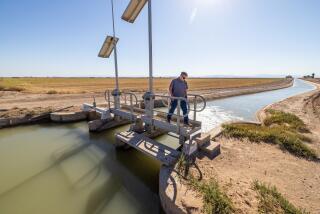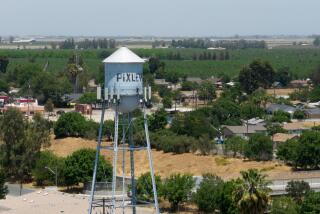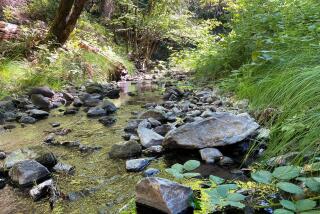Toxic Farm Runoff Perils Wildlife Area
- Share via
Agricultural drain water from large-scale farming near Fallon, Nev., is so toxic that it kills both freshwater fish and invertebrates commonly found in the nearby Stillwater Wildlife Management Area, a preliminary U.S. Fish and Wildlife Service study has found.
The finding was widely viewed Friday as an early signal that the ecological health of the 164,000-acre wildlife refuge 60 miles east of Reno could be in jeopardy. Stillwater is one of only eight shore-bird reserves in the Western Hemisphere and is a major nesting area and migratory stop.
Since 1987, the refuge’s ponds and lakes have been fed exclusively by agricultural drain water. Up until then, the refuge received what amounted to surplus fresh water from both the Carson and Truckee rivers that bypassed 65,000 acres of nearby farmlands.
River Water Diverted
But when growers complied with requests to get by with less water, they used the water more efficiently and in effect left no spillover of fresh water for the refuge. In addition, the U.S. Bureau of Reclamation diverted more water from the Truckee River to Pyramid Lake to save the endangered Quiui fish, which is found only in that lake.
Beginning in late 1986, more than 1,500 birds and upwards of 7 million fish died in the Carson Sink, the terminus of water in the Stillwater refuge. The deaths attracted national attention. At the time, avian cholera was confirmed as the cause of deaths of some of the birds.
But scientists speculated at the time that many of the deaths could be attributed to elevated levels of selenium or mercury in the water. Such substances, which occur naturally in the soil, can become highly concentrated in the drain water that runs into the refuge.
Last May, samples of water were taken from the Stillwater refuge’s Pintail Bay, upstream from the Carson Sink. Samples from the bay, which has since gone dry, were sent to the U.S. Fish and Wildlife Service laboratories in Columbia, Mo.
‘Acutely Toxic’
Fisheries biologist Christopher Ingersoll, author of the study, said in a telephone interview Friday that the agricultural drain water taken from Pintail Bay was “acutely toxic to both freshwater and saltwater fish and invertebrates.”
He said that elevated levels of boron, chromium, copper, zinc, cadmium, arsenic and lead were detected. “While no element was extraordinarily high, it’s very difficult to determine the toxic mechanisms,” he said. The toxic effect of two or more of those substances working in combination could have a greater adverse effect than any one of them by itself, he added.
Both Ingersoll and U.S. Fish and Wildlife Service biologist Steve Thompson said Friday that it is too early to say that there is a definite connection between the deaths about 20 months ago and the toxicity of the agricultural drain water.
More to Read
Sign up for Essential California
The most important California stories and recommendations in your inbox every morning.
You may occasionally receive promotional content from the Los Angeles Times.










